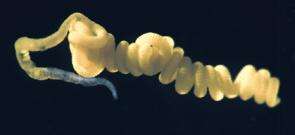Life without a mouth, stomach, or gut

All living organisms are inhabited by a complex community of beneficial microorganisms that are essential for their development, health, and interactions with the environment. Often these microorganisms protect their hosts against harmful bacteria, such as the microbial community of the human skin.
Other microorganisms are essential for their hosts because they either help them digest their food or provide them with nutrition directly. In return, the host offers its bacterial community a stable and secure place to live. These mutually beneficial associations are called symbioses.
Scientists from the Bremen Max Planck Institute for Marine Microbiology and the Joint Genome Institute in the USA have now successfully unraveled the genomes of a complex community of four bacterial symbionts that live inside the marine worm Olavius algarvensis using so-called metagenomic analyses. This study represents the largest genomic dataset of a symbiotic community and provides an important basis for the analysis of other complex symbioses, such as the human gut microbiota (Nature, advanced online publication, September 18, 2006).
Olavius algarvensis is a marine oligochaete that lives in the upper 20 centimeters of shallow-water sands off the coast of the Mediterranean island of Elba. Nicole Dubilier from the Bremen Max Planck Institute for Marine Microbiology together with colleagues from her Symbiosis Group has been working for years on the symbioses of marine oligochaetes. The anatomy of these worms is particularly unusual because they not only lack a mouth, stomach, and gut, but also nephridia, kidney-like organs. While the reduction of the digestive system also occurs in other animals groups, these worms are the only hosts that have also reduced their excretory system as an adaptation to the symbiosis. For the worms, this means that their symbionts are responsible for both providing them with food and removing their waste compounds. The metagenomic analyses revealed how these essential host tasks could be delegated to the symbionts, a wonderful example for outsourcing of energy and waste management.
The genome is the total complement of genes in an organism. In classical genomic analyses, the genetic material of a single species is sequenced using well established methods and every year hundreds of new genomes are published by scientists and deposited in the databases. These classical analyses do not, however, work for samples containing a mixture of species because they do not allow an assignment of the sequences to the species from which they originated. For the study of microbial communities metagenomic analyses are used. The metagenome is defined as the total complement of all genes in an environmental sample.
One of the major challenges in metagenomics is assigning the mixture of genomic sequences from an environmental sample to a given species. This problem can be illustrated with an example from text analyses. Imagine a hopeless mess of books from different authors with the texts broken up in bits and pieces. These must be put back together in their original form. As every author has his or her own unique style of writing, the original texts can be reconstructed by statistically analyzing the text fragments. In genomic "texts", however, there are only four letters, A, G, C, and T. And these letters are not separated by dots or commas. Hanno Teeling from the Microbial Genomics Group of Prof. Frank Oliver Glöckner was able to solve this problem by developing a new mathematical algorithm for so-called binning analyses. The relative frequency of all 64 possible triplets of A,G,C, and T, all 256 possible quadruplets of these four base pairs, and the frequency of G and C in a defined genomic sequence differs distinctly between species. These unique signatures were used to separate the genomic fragments into distinct groups, so-called bins. These fragments were then assembled and annotated, allowing the reconstruction of the genomes of the four symbionts of O. algarvenis. This enabled the scientists to reconstruct the metabolism of the symbionts and revealed which pathways are used under different environmental conditions.
Two sulfur bacteria (Gammaproteobacteria) and 2 sulfate reducers (Deltaproteobacteria) co-occur in the worm. The sulfate reducers produce reduced sulfur compounds that can be used by the sulfur bacteria to gain energy, so that the symbionts feed each other in a syntrophic sulfur cycle. Surprisingly, all four symbionts can fix carbon dioxide as plants do, making these worms comparable to an endosymbiotic power plant. The four symbionts are also involved in the detoxification of poisonous waste products such as urea and ammonium and thus contribute to the recycling of valuable nitrogen.
This little worm shows how the coordinated interaction of its microbial community enables it to efficiently use limited resources in a confined space. This makes the Olavius symbiosis a model for a nearly self-sufficient biosphere. Comparable systems on a much larger scale are currently being studied intensively. These are interesting for long interplanetary space travels, such as the planned flight to Mars.
Citation: Tanja Woyke, et al., Symbiosis insights through metagenomic analysis of a microbial consortium, Nature, advanced online publication, September 18, 2006.
Source: Max-Planck-Institute for Marine Microbiology

















